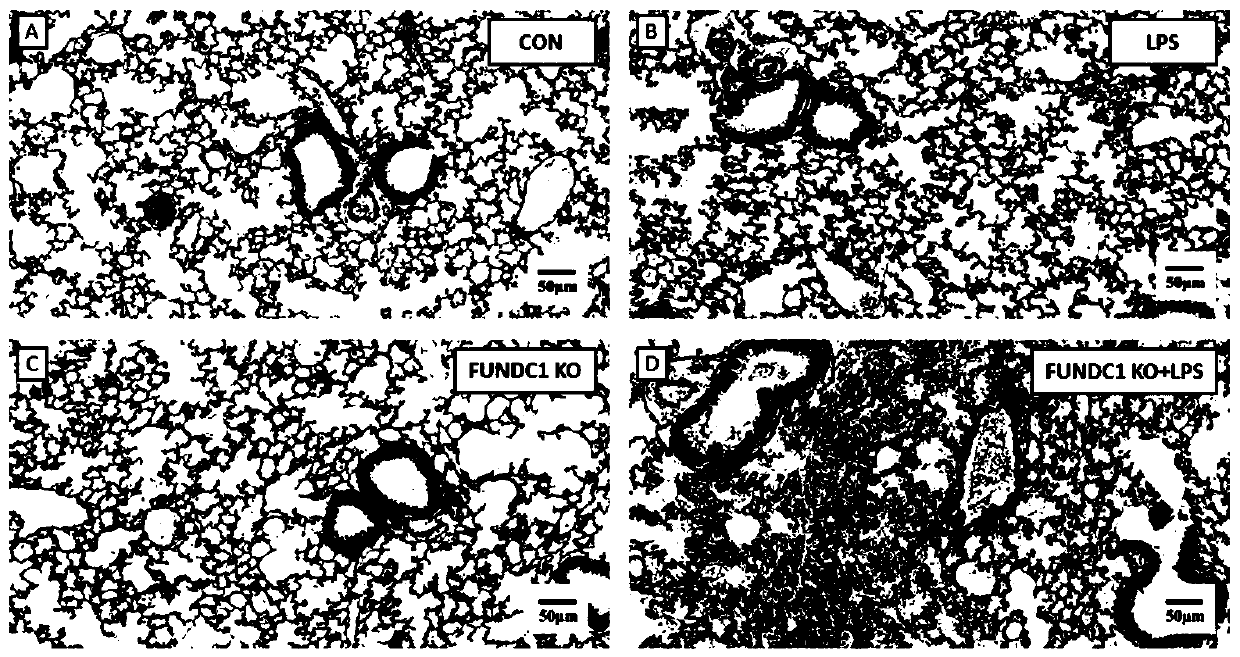Application of FUNDC1 in treating acute respiratory distress syndrome and belongs to technical field of biology
A technology of FUNDC1, 1.FUNDC1, applied in the field of application in the treatment of acute respiratory distress syndrome, capable of solving damage, sepsis organs and other problems
- Summary
- Abstract
- Description
- Claims
- Application Information
AI Technical Summary
Problems solved by technology
Method used
Image
Examples
Embodiment 1
[0038] Embodiment 1 establishes animal model
[0039] Wild-type 6-week-old adult male C57BL / 6J mice and FUNDC1 knockout (FUNDC1-KO) mice were provided by the Department of Biochemistry and Molecular Biology, Institute of Zoology, Chinese Academy of Sciences. Genomic DNA was detected from the tail by PCR amplification to detect the genotype of the knockout mice. Compared with littermates, FUNDC1-KO were not statistically different in sex, age of week and body weight. All experimental animals have health certificates. All FUNDC1-KO and their littermates were kept in a constant temperature (20–24°C) and specific pathogen-free facility. According to the "Guide for the Care and Use of Laboratory Animals" issued by the National Institutes of Health, the mice were allowed free access to food and water, and were kept in a normal state on a 12-h light-dark cycle. All procedures were approved by the Institutional Animal Care and Use Committee (IACUC) of Peking Union Medical College Hos...
Embodiment 2
[0041] Embodiment 2 lung histopathology
[0042] Immediately after the mice were sacrificed, right lower lung tissues were collected and fixed in 10% formalin solution. Tissue samples were dehydrated and embedded in paraffin. Serial paraffin sections (4um) were obtained and kept at 37°C for more than 12h. Sections were immersed in three consecutive washes of xylenol for 5 min to remove paraffin, then hydrated with five consecutive washes of decreasing alcohol content: 100%, 95%, 80%, 70%, 50%, and finally with deionized Wash with water. Then the tissue paraffin sections were stained with HE. Changes in tissue structure were observed using a light microscope. Two professional pathologists were invited to score lung lesions according to a blinded method. The scoring criteria are based on six pathological features: (1) alveolar edema; (2) interstitial edema; (3) inflammatory cell infiltration; (4) lung wall thickening; (5) atelectasis; (6) Transparent film. Each of the pat...
Embodiment 3
[0044] Example 3 Pulmonary tissue inflammatory infiltration and lung injury
[0045] Neutrophils are an important marker of leukocyte inflammatory response in acute lung injury. The inventors also performed neutrophil counts in alveolar lavage fluid using HE stain. The result is as figure 2 As shown in A, compared with the WT+LPS group and the FUNDC-1 KO or normal control group, the FUNDC-1 KO+LPS group had more neutrophil infiltration (1.08±0.08×10 3 / ml vs. 0.75±0.07×10 3 / ml vs. 0.20±0.04×10 3 / ml vs. 0.19±0.03×10 3 / ml, P<0.05).
[0046] In addition, the inventor detects the myeloperoxidase (MPO) activity (Catalog# A044-1-1 , Jiancheng Biological Engineering Company, Nanjing). MPO is a marker enzyme of neutrophil activation, and the change of its content reflects the infiltration of neutrophils. The result is as figure 2 As shown in B, MPO concentration presents the same expression trend. Compared with WT+LPS group, FUNDC1 KO group or normal control group, FUND...
PUM
 Login to View More
Login to View More Abstract
Description
Claims
Application Information
 Login to View More
Login to View More - R&D Engineer
- R&D Manager
- IP Professional
- Industry Leading Data Capabilities
- Powerful AI technology
- Patent DNA Extraction
Browse by: Latest US Patents, China's latest patents, Technical Efficacy Thesaurus, Application Domain, Technology Topic, Popular Technical Reports.
© 2024 PatSnap. All rights reserved.Legal|Privacy policy|Modern Slavery Act Transparency Statement|Sitemap|About US| Contact US: help@patsnap.com










